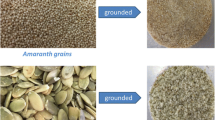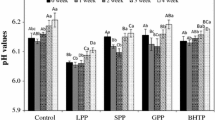Abstract
The aim was to evaluate the effects of hazelnut skin (HS) addition on the oxidation and sensorial properties of chicken burgers during storage and after cooking. Burgers were prepared and divided in five groups: [C] control without HS addition, [CAA] control with ascorbic acid, and [HS1] 1%, [HS2] 2% and [HS3] 3% HS addition. Burgers for each batch were prepared in triplicate and analysed raw and cooked after 1 and 4 days of refrigerated storage (4 ± 1 °C), respectively. Lipid oxidation was assessed by monitoring malonaldehyde formation with a 2-thiobarbituric acid reactive substances assay, and antioxidant capacity was assessed with 2,2-diphenyl-1-picrylhydrazyl (DPPH) and ferric reducing antioxidant power (FRAP) methods. A sensory evaluation was performed by twenty experienced panellists, and the attributes that were measured were: colour, greasiness, flavour, odour, juiciness, granulosity, chewiness and overall acceptability. Lipid oxidation values were higher in the HS burgers than in the C and CAA burgers, except for the cooked burgers at day 4. HS addition had a significant effect with a decrease in diameter and an increase in fat retention. In all treatments, FRAP was lower in the C and HS groups than in the CAA group, except for cooked burgers at day 4, where the values of the HS2, HS3 and CAA groups were similar. The DPPH assay showed higher values on both days for the raw and cooked burgers treated with CAA or HS compared to the control group. HS addition influenced only meat colour among the sensorial parameters that were considered.

Similar content being viewed by others
References
Agourram A, Ghirardello D, Rantsiou K, Zeppa G, Belviso S, Romane A, Oufdou K, Giordano M (2013) Phenolic content, antioxidant potential and antimicrobial activities of fruit and vegetable by-product extracts. Int J Food Sci Technol 16:1092–1104
Alasalvar C, Karamać M, Amarowicz R, Shahidi F (2006) Antioxidant and antiradical activities in extracts of hazelnut kernel (Corylus avellana L.) and hazelnut green leafy cover. J Agric Food Chem 54:4826–4832
Alesson-Carbonell L, Fernández-López J, Pérez-Alvarez JA, Kuri V (2005) Characteristics of beef burger as influenced by various types of lemon albedo. Inn Food Sci Emerg Technol 6:247–255
Amarowicz R, Pegg RB (2001) Assessment of the antioxidant and pro-oxidant activities of tree nut extracts with a pork model system. Anim Reprod Food Res 10:745–747
Amarowicz R, Karamać M, Kmita-Głażewska H, Troszyńska A, Kozłowska H (1996) Antioxidant activity of phenolic fractions of everlasting pea, faba bean and broad bean. J Food Lipids 3:199–211
Amarowicz R, Estrella I, Hernández T, Troszyńska A (2008) Antioxidant activity of extract of adzuki bean and its fractions. J Food Lipids 15:119–136
AMSA (1995) Research guidelines for cookery, sensory evaluation and instrumental tenderness measurements of fresh meat. American Meat Science Association, Chicago
Anil M (2007) Using of hazelnut testa as a source of dietary fiber in breadmaking. J Food Eng 80:61–67
AOAC (2000) Official methods of analysis of AOAC International, 17th edn. Association of Official Analytical Chemists, Gaithersburg
ASTM (1988) Standards on sensory evaluation of materials and products. American Society for Testing and Materials, Philadelphia
Benzie IEF, Strain JJ (1990) Ferric reducing/antioxidant power assay: direct measure of total antioxidant activity of biological fluids and modified version for simultaneous measurement of total antioxidant power and ascorbic acid concentration. Meth Enzym 299:15–27
Bertolino M, Belviso S, Dal Bello B, Ghirardello D, Giordano M, Rolle L, Gerbi V, Zeppa G (2015) Influence of the addition of different hazelnut skins on the physicochemical, antioxidant, polyphenol and sensory properties of yogurt. LWT - Food Sci Technol 63:1145–1154
Brand-Williams W, Cuvelier ME, Berset C (1995) Use of free radical method to evaluate antioxidant activity. Lebensm-Wiss Technol 28:25–30
Buege JA, Aust SD (1978) Microsomal lipid peroxidation. Meth Enzym 52:306–307
Caimari A, Puiggròs F, Suárez M, Crescenti A, Laos S, Ruiz JA, Alonso V, Moragas J, del Bas JM, Arola L (2015) The intake of a hazelnut skin extract improves the plasma lipid profile and reduces the lithocholic/deoxycholic bile acid faecal ratio, a risk factor for colon cancer, in hamsters fed a high-fat diet. Food Chem 167:138–144
Contini M, Baccelloni S, Frangipane MT, Merendino N, Massantini R (2012) Increasing espresso coffee brew antioxidant capacity using phenolic extract recovered from hazelnut skin waste. J Funct Foods 4:137–146
Del Rio D, Calani L, Dall’Asta M, Brighenti F (2011) Polyphenolic composition of hazelnut skin. J Agric Food Chem 59:9935–9941
Dervisoglu M (2006) Influence of hazelnut flour and skin addition on the physical, chemical and sensory properties of vanilla ice cream. Int J Food Sci Technol 41:657–661
FAOSTAT (2012) http://www.fao.org/docrep/003/x4484e/x4484e03.htm Accessed date 10 Jan 2018
Hui YH, Guerrero-Legarreta I (2010) Overview of processed poultry products. Handb Poult Sci Technol Second Process 2:127–142
Jakopic J, Mikulic-Petkovsek M, Likozar A, Solar A, Stampar F, Veberic R (2011) HPLC–MS identification of phenols in hazelnut (Corylus avellana L.) kernels. Food Chem 124:1100–1106
Karamać M, Biskup I, Kulczyk A (2015) Fractionation of buckwheat seed phenolics and analysis of their antioxidant activity. Pol J Food Nutr Sci 65:243–249
Kumar Y, Yadav DN, Ahmad T, Narsaiah K (2015) Recent trends in the use of natural antioxidants for meat and meat products. Compr Rev Food Sci Food Saf 14:796–812
Locatelli M, Travaglia F, Coïsson JD, Martelli A, Stévigny C, Arlorio M (2010) Total antioxidant activity of hazelnut skin (Nocciola Piemonte PGI): impact of different roasting conditions. Food Chem 119:1647–1655
Longato E, Lucas-González R, Peiretti PG, Meineri G, Pérez-Alvarez JA, Viuda-Martos M, Fernández-López J (2017) The effect of natural ingredients (amaranth and pumpkin seeds) on the quality properties of chicken burgers. Food Bioprocess Technol 10:2060–2068
Magdelaine P, Spiess MP, Valceschini E (2008) Poultry meat consumption trends in Europe. World’s Poultry Sci J 64:53–64
OECD/FAO (2015) Agricultural Outlook 2015. Organisation for Economic Co-operation and Development/Food and Agriculture Organization of the United Nations Publishing, Paris
Oyaizu M (1986) Studies on products of browning reaction: antioxidative activity of products of browning reaction prepared from glucosamine. Jpn J Nutr 44:307–315
Peiretti PG, Gai F (2015) Fruit and pomace extracts: applications to improve the safety and quality of meat products. In: Owen JP (ed) Fruit and pomace extracts: biological activity, potential applications and beneficial health effects. Nova Science Publishers, Inc., New York, pp 1–28
Prior RL, Wu X, Schaich K (2005) Standardized methods for the determination of antioxidant capacity and phenolics in foods and dietary supplements. J Agric Food Chem 53:4290–4302
Re R, Pellegrini N, Proteggente A, Pannala A, Yang M, Rice-Evans C (1999) Antioxidant activity applying an improved ABTS radical cation decolorization assay. Free Radical Biol Med 26:1231–1237
Sampaio GR, Saldanha T, Soares RAM, Torres EAFS (2012) Effect of natural antioxidant combinations on lipid oxidation in cooked chicken meat during refrigerated storage. Food Chem 135:1383–1390
Sánchez-Zapata E, Muñoz CM, Fuentes E, Fernández-López J, Sendra E, Sayas E, Navarro C, Pérez-Alvarez JA (2010) Effect of tiger nut fibre on quality characteristics of pork burger. Meat Sci 85:70–76
Serrano A, Cofrades S, Jiménez-Colmenero F (2007) Characteristics of restructured beef steak with different proportions of walnut during frozen storage. Meat Sci 72:108–115
Shahidi F, Alasalvar C, Liyana-Pathirana CM (2007) Antioxidant phytochemicals in hazelnut kernel (Corylus avellana L.) and hazelnut by-products. J Agric Food Chem 55:1212–1220
Turhan S, Sagir I, Ustun NS (2005) Utilization of hazelnut pellicle in low-fat beef burgers. Meat Sci 71:312–316
Acknowledgements
The work was funded by the University of Torino (Grant Number UA.A200.D224 MEIG_RIC_LOC_14_01: “Valutazione del potenziale antiossidante di vegetali e loro applicazione sulla qualità della carne avicola”). The authors would like to thank American Journal Experts for language review of the manuscript and Chiara Bianchi for her technical support.
Author information
Authors and Affiliations
Corresponding author
Ethics declarations
Conflict of interest
The authors declare that they have no conflict of interest.
Additional information
Publisher's Note
Springer Nature remains neutral with regard to jurisdictional claims in published maps and institutional affiliations.
Rights and permissions
About this article
Cite this article
Longato, E., Meineri, G., Peiretti, P.G. et al. Effects of hazelnut skin addition on the cooking, antioxidant and sensory properties of chicken burgers. J Food Sci Technol 56, 3329–3336 (2019). https://doi.org/10.1007/s13197-019-03813-7
Revised:
Accepted:
Published:
Issue Date:
DOI: https://doi.org/10.1007/s13197-019-03813-7




